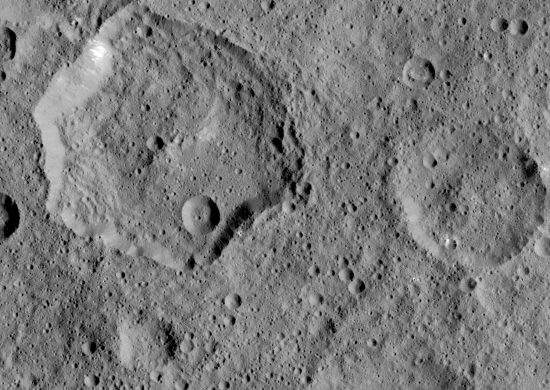
October 2, 2020
The Solar System was chaotic a few thousand years ago.
The features on all the moons and rocky planets support that idea. How many thousands of years ago that chaos occurred isn’t important, since it is not millions of years, or even hundreds of thousands of years under consideration. The Electric Universe premise is that electricity from highly active celestial objects discharged many times to the surfaces of most Solar System bodies.
130-kilometer-wide Herschel crater on Saturn’s moon Mimas and 34-kilometer-wide Haulani crater on Ceres, along with countless other examples, are hexagonal formations. Such craters are theorized to form when asteroids impact the surface and explode, blasting the material into space.
One standard explanation for why so little debris remains behind is that the moons, like Mimas, (or dwarf planets like Ceres) have little gravitational attraction, so the remnants of the explosive events do not fall back. It sounds like a reasonable explanation until one examines the craters on large planets like Earth and Mars. Many hundred-kilometer-wide “impact sites” on Earth also demonstrate little in the way of fallback breccias – their flat-bottomed floors and steep sidewalls are swept clean, although glassified material is often incorporated into their rims and walls.
How can the detonation of a colliding rock cause a hexagonal crater? No experiment has been able to demonstrate a polygonal shape left behind after an explosive event. Explosions do not aggregate constituent particles into stable configurations; they induce chaotic behavior.
Most planetary scientists think that polygons on small moons are caused by the existence of fractures in their crusts, and the craters followed those weaknesses, making straight rim segments. To propose that it is pre-existing stress patterns is to say that straight-edged, underground faults and cracks are everywhere, not just on moons, and are in just the right arrangements for square, pentagonal or hexagonal formations.
The answer to how craters with similar morphology can develop with straight-sided polygons is found in plasma discharge experiments. In previous Picture of the Day articles, evidence was provided for plasma discharges on planets and moons. As mentioned, electrical activity in the form of lightning bolts, diffuse glow-mode clouds of energetic particles and rotating Birkeland currents could be the formative agents for bizarre conditions on celestial bodies. Those bodies might have been caught in titanic particle beams that excavated craters and the other geological features. Due to plasma instabilities in the discharge, hexagons were deeply cut. When the electrical energy was withdrawn, craters remained, “fossilized” geometric shapes permanently burned-in.
It is not beyond reason to suggest that star systems experience extreme duress. Some speculate that rocky bodies are expelled from stars and gas giants because of an electrical imbalance that appears to be common in the Milky Way. Maybe some celestial bodies are not local to the Solar System but arrived from great distances.
If gas giants and stars give birth through electrical parturition, and the planet hunters claim hundreds of gas giant-like planets, revolving at distances closer than Mercury is to the Sun, then those planets are most likely experiencing rapid modification due to electrical interactions with their parent bodies. The Milky Way could be a wilderness of rocky bodies of every shape and size ejected from stars, especially brown dwarf stars, orbiting more powerful, more violent companions.
Stephen Smith












